Intel Ghost Canyon NUC9i9QNX Review: NUC 9 Extreme Realizes the SFF Dream
by Ganesh T S on April 16, 2020 8:05 AM ESTSPECworkstation 3 Benchmark
SFF PCs traditionally do not lend themselves to workstation duties. However, the capabilities of the Ghost Canyon NUC encouraged us to benchmark the unit as a content creation machine. Other professional workloads were also processed using the SPECworkstation 3.0.4 benchmark from the SPEC Graphics & Workstation Performance Group.
The SPECworkstation 3 benchmark measures workstation performance based on a number of professional applications. It includes more than 140 tests based on 30 different workloads that exercise the CPU, graphics, I/O and memory hierarchy. These workloads fall into different categories.
- Media and Entertainment (3D animation, rendering)
- Product Development (CAD/CAM/CAE)
- Life Sciences (medical, molecular)
- Financial Services
- Energy (oil and gas)
- General Operations
- GPU Compute
Individual scores are generated for each test and a composite score for each category is calculated based on a reference machine (HP Z240 tower workstation using an Intel E3-1240 v5 CPU, an AMD Radeon Pro WX3100 GPU, 16GB of DDR4-2133, and a SanDisk 512GB SSD). The SPEC Ratio for the tests in each category is presented in the graphs below.
Media and Entertainment
The Media and Entertainment category comprises of workloads from five distinct applications:
- The Blender workload measures system performance for content creation using the open-source Blender application. Tests include rendering of scenes of varying complexity using the OpenGL and ray-tracing renderers.
- The Handbrake workload uses the open-source Handbrake application to transcode a 4K H.264 file into a H.265 file at 4K and 2K resolutions using the CPU capabilities alone.
- The LuxRender workload benchmarks the LuxCore physically based renderer using LuxMark.
- The Maya workload uses the SPECviewperf 13 maya-05 viewset to replay traces generated using the Autodesk Maya 2017 application for 3D animation.
- The 3ds Max workload uses the SPECviewperf 13 3dsmax-06 viewset to replay traces generated by Autodesk's 3ds Max 2016 using the default Nitrous DX11 driver. The workload represents system usage for 3D modeling tasks.
| SPECworkstation 3.0.4 - Media and Entertainment Workloads | |||
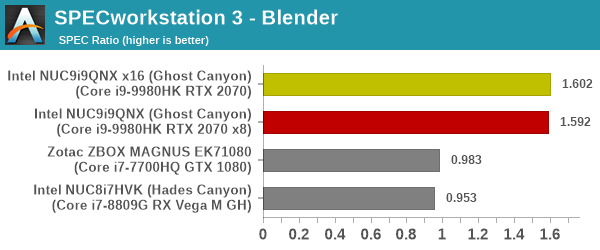
We find the Ghost Canyon NUC performing better than the reference configuration across all content creation workloads typically seen in the media and entertainment industry.
Product Development
The Product Development category comprises of eight distinct workloads:
- The Rodinia (CFD) workload benchmarks a computational fluid dynamics (CFD) algorithm.
- The WPCcfd workload benchmarks another CFD algorithm involving combustion and turbulence modeling.
- The CalculiX workload uses the Calculix finite-element analysis program to model a jet engine turbine's internal temperature.
- The Catia workload uses the catia-05 viewset from SPECviewperf 13 to replay traces generated by Dassault Systemes' CATIA V6 R2012 3D CAD application.
- The Creo workload uses the creo-02 viewset from SPECviewperf 13 to replay traces generated by PTC's Creo, a 3D CAD application.
- The NX workload uses the snx-03 viewset from SPECviewperf 13 to replay traces generated by the Siemens PLM NX 8.0 CAD/CAM/CAE application.
- The Solidworks workload uses the sw-04 viewset from SPECviewperf 13 to replay traces generated by Dassault Systemes' SolidWorks 2013 SP1 CAD/CAE application.
- The Showcase workload uses the showcase-02 viewset from SPECviewperf 13 to replay traces from Autodesk’s Showcase 2013 3D visualization and presentation application
| SPECworkstation 3.0.4 - Product Development Workloads | |||
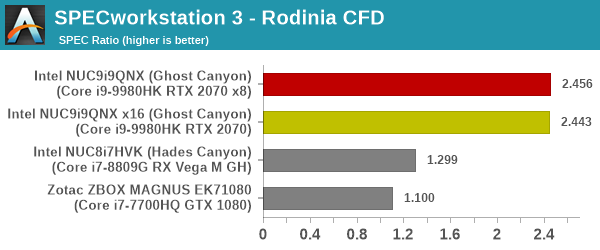
Almost all workloads see the Ghost Canyon NUC performing significantly better than the reference configuration. The NX workload alone seems to suffer, likely on account of the trace requiring features supported in professional graphics cards.
Life Sciences
The Life Sciences category comprises of four distinct test sets:
- The LAMMPS set comprises of five tests simulating different molecular properties using the LAMMPS molecular dynamics simulator.
- The NAMD set comprises of three tests simulating different molecular interactions.
- The Rodinia (Life Sciences) set comprises of four tests - the Heartwall medical imaging algorithm, the Lavamd algorithm for calculation of particle potential and relocation in a 3D space due to mutual forces, the Hotspot algorithm to estimate processor temperature with thermal simulations, and the SRAD anisotropic diffusion algorithm for denoising.
- The Medical workload uses the medical-02 viewset from SPECviewperf 13 to determine system performance for the Tuvok rendering core in the ImageVis3D volume visualization program.
| SPECworkstation 3.0.4 - Life Sciences Workloads | |||
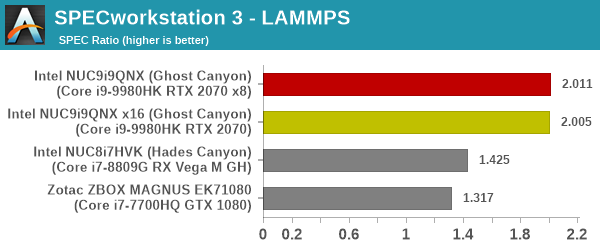
The trend repeats for all test sets in this category also, with the Ghost Canyon NUC acquitting itself in a creditable manner.
Financial Services
The Financial Services workload set benchmarks the system for three popular algorithms used in the financial services industry - the Monte Carlo probability simulation for risk assessment and forecast modeling, the Black-Scholes pricing model, and the Binomial Options pricing model.
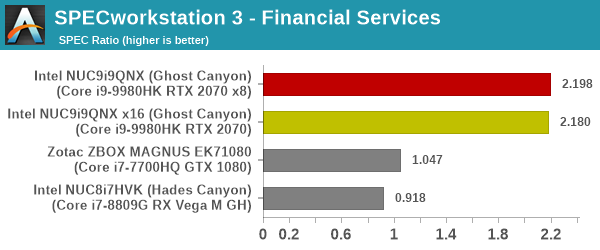
The large core count and ability to turbo to speeds of up to 5 GHz enable the NUC9i9QNX to process these algorithms in a fast manner.
Energy
The Energy category comprises of workloads simulating various algorithms used in the oil and gas industry:
- The FFTW workload computes discrete Fourier transforms of large matrices.
- The Convolution workload computes the convolution of a random 100x100 filter on a 400 megapixel image.
- The SRMP workload processes the Surface-Related Multiples Prediction algorithm used in seismic data processing.
- The Kirchhoff Migration workload processes an algorithm to calculate the back propogation of a seismic wavefield.
- The Poisson workload takes advantage of the OpenMP multi-processing framework to solve the Poisson's equation.
- The Energy workload uses the energy-02 viewset from SPECviewperf 13 to determine system performance for the open-source OPendTec seismic visualization application.
| SPECworkstation 3.0.4 - Energy Industry Workloads | |||

The NUCs seem to perform very poorly in the SRMP and Poisson workloads, but are otherwise quite good in the workloads in this category.
General Operations
In the General Options category, the focus is on workloads from widely used applications in the workstation market:
- The 7zip workload represents compression and decompression operations using the open-source 7zip file archiver program.
- The Python workload benchmarks math operations using the numpy and scipy libraries along with other Python features.
- The Octave workload performs math operations using the Octave programming language used in scientific computing.
- The Storage workload evaluates the performance of the underlying storage device using transaction traces from multiple workstation applications.
| SPECworkstation 3.0.4 - General Operations | |||
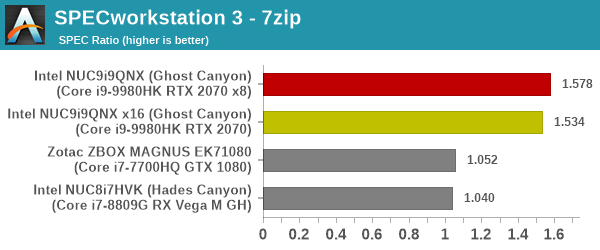
The Core i9-9980HK performs much better than the reference configuration as well as the older generation CPUs for the general operations. The storage results is again particularly interesting to analyze. Directly connecting the Optane SSD to the CPU's PCIe lanes results in a 40%+ performance improvement for the storage traces of professional applications.
GPU Compute
In the GPU Compute category, the focus is on workloads taking advantage of the GPU compute capabilities using either OpenCL or CUDA, as applicable:
- The LuxRender benchmark is the same as the one seen in the media and entertainment category.
- The Caffe benchmark measures the performance of the Caffe deep-learning framework.
- The Folding@Home benchmark measures the performance of the system for distributed computing workloads focused on tasks such as protein folding and drug design.
| SPECworkstation 3.0.4 - GPU Compute | |||
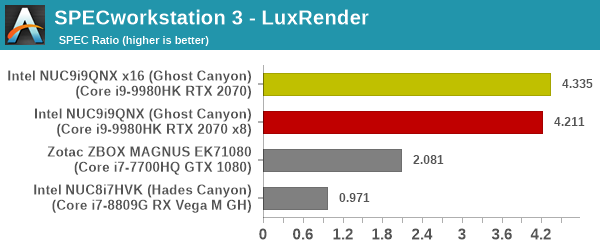










109 Comments
View All Comments
Silma - Friday, April 17, 2020 - link
Just saw your gaming benchmarks are in 720p. Why?If this computer can't have decent gaming at 1080p, what's the point of spending $1,300 ?
ganeshts - Friday, April 17, 2020 - link
Some are at 720p to provide context when compared with older SFF PCs we have evaluated before. Every benchmark has a 4K entry too. Please click the appropriate selection button to view the 4K comparison graph.nandnandnand - Friday, April 17, 2020 - link
Turn your script blocker off if you don't see any buttons for 1080p, 2160p, etc.ballsystemlord - Friday, April 17, 2020 - link
@Ganesh This review is far more complete then the recent AMD laptop one. Why?I was really hoping for more details but then thought you might have reduced the amount of benchmarks only to see you're fine review on this NUC.
ganeshts - Friday, April 17, 2020 - link
Different reviewers having different amounts of time to spend on a particular review. Ian covers a lot lot more things than I do (I publish one or two pieces a month, Ian publishes two or three a week)ballsystemlord - Friday, April 17, 2020 - link
I'm sorry to hear that Ian's so busy. Thanks for your fast reply!ballsystemlord - Friday, April 17, 2020 - link
I noticed one spelling error (I didn't read the whole thing throughly):"Though make no mistake: while biggest than the smallest NUCs, this is still well within the realm of SFF PCs."
Incorrect suffix:
"Though make no mistake: while bigger than the smallest NUCs, this is still well within the realm of SFF PCs."
Namisecond - Friday, April 17, 2020 - link
Ganesh brings up an interesting comparison to the Zotac discrete GPU boxes. Those are very hit or miss, because of their very niche, boutique pricing and Intel wants to charge almost double what Zotac is charging. They're both in the same, roughly 5 Liter, range with a very similar features list, including a standard PCIe graphics card on a PCIe x16 slot. But how does that compare to a DIY enthusiast build?Well I've got news for Intel. I just built a 5.25 Liter SFF PC using off-the-shelf, industry standard desktop components for around $700USD (the BoM might be $800 now). The ease of upgrading and appearance is arguably better too. No cheap plastic trim. If something breaks, I can hit up a plethora of 3rd party vendors for spare parts. Why did I build this specific machine? Because of the hype around the NUC 9 announcement 3-4 months back. I wanted to see where the state of DIY SFF was. Back in the days when I first got started building SFFs, case choices were very slim and they were pretty big. It all came down to the enclosures. Now with cases like the Velka 3, the Geeek A30 and the no-name Shenzen K39, companies like Zotac and Intel have to step up their game, especially for the prices they're charging. For Zotac, I think they'll continue on doing as they have. The price premium they charge can be justified, to an enthusiast, as time saved in sourcing and building. Intel's NUC 9 on the other hand....probably won't do very well. The price premium they charge is very hard to justify, considering vendor and platform lock-in...unless you place a high value on bragging rights.
Deicidium369 - Sunday, April 19, 2020 - link
I have had NUCs since the first model and have over 60 deployed as we speak. The original was used non stop for 3 years as a MQTT server - and had never had issues - I have had absolutely zero failures or issues - did get a bum stick of RAM that took a bit to diag.I agree that this and the Comet Lake NUC will not do great - I think Comet Lake in general is not going to do well - even if you need a machine TODAY, and want an upgrade path to Rocket Lake fine - socket compatible - but won't have PCIe4 that the "Z590" will have so....
Am looking forward to the NUC10 with Tiger Lake.
kwinz - Friday, April 17, 2020 - link
If you are wondering about similar size AMD Zen2 8 core products check out the HP EliteDesk 705 G5 Small Form Factor computer. It's absolutely amazing for the size and comes with up to 4 year on site warranty for business customers.